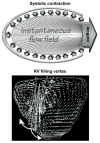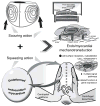Diastolic filling vortex forces and cardiac adaptations: probing the epigenetic nexus
- PMID: 23178429
- PMCID: PMC5789446
Diastolic filling vortex forces and cardiac adaptations: probing the epigenetic nexus
Figures





References
-
- Pasipoularides A. Heart’s vortex: intracardiac blood flow phenomena. Shelton, CT: People’s Medical Publishing House; 2010. p. 960. p. See, in particular, Chapter 9. Vortex formation in fluid flow, p. 442–480.
-
-
ibid. See, particularly, Chapter 5. Micromanometric, velocimetric, angio- and echocardiographic measurements, p. 234–297, Chapter 10. Cardiac computed tomography, magnetic resonance, and real-time 3-D echocardiography, p. 482–581, and Chapter 11. Postprocessing exploration techniques and display of tomographic data, p. 582–622.
-
-
- Brutsaert DL. Cardiac endothelial-myocardial signaling: its role in cardiac growth, contractile performance, and rhythmicity. Physiol Rev. 2003;83:59–115. - PubMed
-
- Pasipoularides A, Palacios I, Frist W, Rosenthal S, Newell JB, Powell WJ., Jr Contribution of activation-inactivation dynamics to the impairment of relaxation in hypoxic cat papillary muscle. Am J Physiol. 1985;248(1 Pt 2):R54–62. - PubMed
Publication types
MeSH terms
Grants and funding
LinkOut - more resources
Full Text Sources
